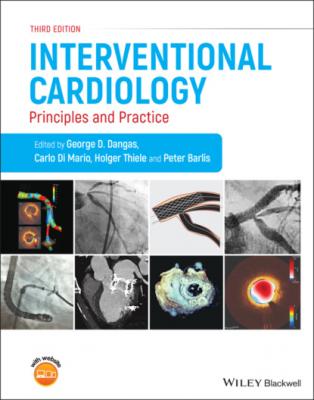Interventional Cardiology. Группа авторов
Читать онлайн.| Название | Interventional Cardiology |
|---|---|
| Автор произведения | Группа авторов |
| Жанр | Медицина |
| Серия | |
| Издательство | Медицина |
| Год выпуска | 0 |
| isbn | 9781119697381 |
Workhorse guidewires typically have soft tips, but the amount of shaft support varies (Table 5.5). Although some wires have preshaped tips, the tip stiffness can be increased by heating it during the preshaping process and the standard (30 degrees, 2‐3 mm from the tip) angle may not match the anatomy. As a result, preshaping rarely offers an advantage except perhaps for polymer‐coated wires, which can be difficult to shape, or for CTO wires where a fixed more durable very small primary curve is preferable. Guidewire shaping can be achieved in many ways including curling the shaping ribbon of the wire over the side of the introducer needle, advancing the wire through the introducer tip and bending it gently outside of the introducer needle tip, or curling it with a finger. It does not matter which method is used to shape the wire tip, provided that it is done gently without damaging the wire. When shaping the tip of a wire, the primary curve should match the greatest angle to be negotiated, whereas the secondary curve is chosen to match the size of the vessel (Figure 5.9).
Figure 5.9 Distal tip styles and components contributing to the crossing profile of balloon catheters.
Polymer coated wires are not recommended as a first choice for general purpose use, because the highly lubricious tip can easily slip beneath a plaque and create a dissection during insertion. These wires also have a higher tendency to migrate distally and increase the risk of perforation, give less tactile feedback, and have lower visibility. Highly tortuous vessels require a flexible lubricious wire in the first instance (e.g. BMW Universal, WhisperMS, Choice floppy), which can then be exchanged via an OTW microcatheter for a more supportive wire (e.g. Choice extra support, Mailman, Ironman, Sion Blue ES, Grand Slam, Platinum Plus).
The handling characteristics of different wires vary substantially and even the same wire can have a very different “feel” under different circumstances. For example, wires frequently perform differently and offer different tactile feedback in more complex lesion subsets including those with diffuse disease with heavy calcification or angulation. Unexperienced operators often progress more confidently by becoming familiar with one workhorse wire used for most cases. Nitinol wires are more forgiving and can be reshaped. An important principle is never to push when the wire bends or buckles, but rather to withdraw and rotate before gently re‐advancing it. Learning how to exchange a wire using OTW microcatheters is an essential skill before tackling complex lesions. More complex angioplasty will also provide an opportunity to gain familiarity with an expanded range of wires.
Dedicated wires for treating CTO have stiffer tips. Tip stiffness is measured in grams of forward pressure required to flex the tip. Specialty wires are listed in Table 5.5 and are discussed in other chapters. Over the last two decades, technologies used for CTO recanalization have emerged with the production of wires specially developed to satisfy the demand of operators involved in this challenging field. The development of new interventional recanalization techniques has been followed by a concomitant increase in the number of specialized wires for specific applications.
The Sion and Suoh 03 wires are currently the gold standard for septal or epicardial collateral tracking, because of their unique trackability which enables the wire to follow most collateral bends. Using this innovative wires, epicardial connections are successfully utilized in almost 35% of retrograde cases in contemporary series from Japan [17,18]. It uses a composite core technology that includes multiple wire components to enhance durability and torque transmission. The tip of the Sion wire can be shaped and a larger than expected curve (70 degrees) near the tip (1 mm) is recommended and may need reshaping during the procedure. The Suoh 03 has a preshaped tip that surprisingly retains its shape through tortuous collateral tracking. These wires can be extremely helpful also outside the CTO field, for instance to gently regain the distal lumen in the presence of spontaneous or iatrogenic (post‐PCI) dissections. Polymer jacketed tapered soft guidewires (Fielder XTR, Sion Black) with composite core technology can greatly facilitate crossing subocclusive calcific lesions in tortuous arteries, overcoming the limitations of poor GC support. These wires should always be advanced over a microcatheter to increase support at the tip, when needed, and to exchange them after crossing with a workhorse wire using trapping.
Balloon catheters
Balloon catheters remain an important tool in interventional cardiology despite the advent of adjunctive devices such as stents. When Gruentzig first introduced coronary angioplasty balloons, the correct choice of balloon diameter and length, compliance,
